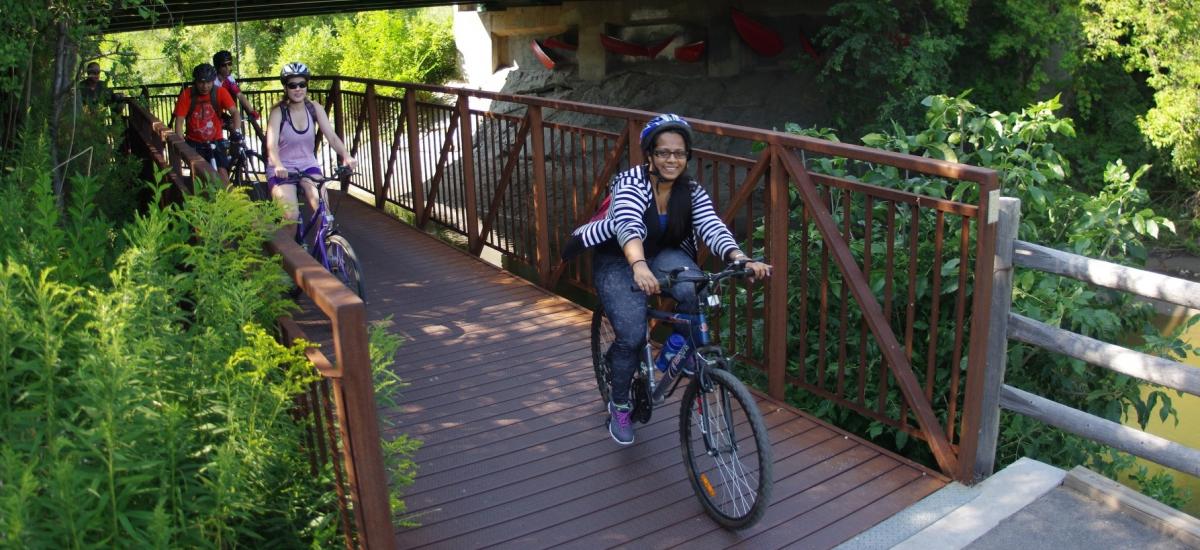Spring Spruce Up: How to ABC Safety Check your bike

If you’re looking for something a little more interactive, we offer workshops year-round. Check out our events page to see what’s coming up.
Spring Spruce Up: How to ABC Safety Check your bike
Whether you’ve been riding all winter, you’re getting your bike out for the first time in a while, or you're headed out for your regular ride there are a few simple things you can do to make sure your bike is safe and ready to go… it’s as simple as ABC.
A: Air & Wheels
Your wheels need to roll right to keep you going.
If you have a pump that has an air pressure gauge, check the tire pressure on the sidewall of the tire and inflate to match. It should indicate the pressure using the measurement pounds per inch (psi).
| My bike pump doesn’t have an air pressure gauge. |
|
No problem! Place the palm of your hand on the top of your tire and lean into it. The tire should feel firm, like you’re putting your hand on your forehead. |
To check your wheels give them a spin! They shouldn’t wobble or touch your brakes as they go around. You should also give your spokes a squeeze to make sure they aren’t really loose. If the spokes are loose or your wheel wobbles you should consider taking your bike to a mechanic.
Once you’ve pumped your tires for the first time, make a habit of it! If you ride daily, aim to pump your tires once a week. Keeping your tires well-inflated will mean that when you bike over a bump or pothole, they will be less likely to get a flat.
B: Brakes & Bars
If your brakes and bars aren’t working right it’s easy to end up on the pavement.
To check your brakes, first squeeze the left brake and push your bike forward. The rear wheel should lift into the air. If the wheel spins you may need new brakes or an adjustment. Next, squeeze the right brake and push the bike forward. The rear wheel should slide and not spin. Brake components, including the brake pads, cables, and cable housing, wear out over time, so it’s normal to replace them every so often.
| My brake handle touches the handlebars when I squeeze it. |
|
There’s a quick fix: Follow the cable from handle to brake. Along the cable there will be nut that you can turn to loosen or tighten the pressure. |
To check the bars, stand facing the back of the bike with the front wheel clamped tightly between your legs. Give the bars a good wiggle. They shouldn’t move.
C: Chain & Crank
Chains wear out over time and winter riding can make this happen faster if extra care isn’t taken. A clean chain is shiny and metallic. If your chain is rusty or brown it may need replacing, but try cleaning it first!
- Get a rag (old t-shirts work great) and some bicycle chain lubricant from any bike shop.
- Clean the chain by rubbing the rag on it and pedalling backward. You can also use a toothbrush if there is a lot of buildup on your chain.
- Put a drop of lubricant on every chain link and spin the chain through a couple of times.
- Let the lubricant settle in for a while and wipe off the excess with the rag.
| When I change gears the chain doesn’t always move. |
|
This might be an indication that your chain is worn out, but it might also mean your derailleur needs adjustment. Many bike shops are happy to check this out for you if you swing by. |
Your crank attaches your pedals to the frame. They should only move in a circular motion and that’s what you’ll test. Get your hands on the cranks and give them wiggle in and out from the bike. No motion; no problem.
Cycle Toronto relies on support from people like you to develop and deliver educational programs. If you want more people to enjoy cycling in Toronto, please consider becoming a member or making a donation.
